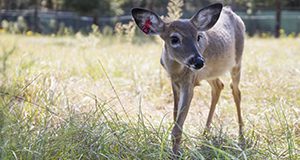
Lumpy jaw is a deer health problem that all deer farmers eventually face. It gets its name from the swollen jaws or cheeks and necrotic lesions it causes in and around the jaw bones of animals including white-tailed deer. The disease is considered a significant problem for deer farms in North America, where it is one of the most important production-limiting diseases and causes high rates of mortality in fawns. This 4-page fact sheet written by Juan M. Campos Krauer, Samantha M. Wisely, and Hannah M. Barber and published by the UF/IFAS Department of Wildlife Ecology and Conservation explains how deer acquire lumpy jaw, how to spot it in deer, how to treat it, and how to prevent it in the first place.
https://edis.ifas.ufl.edu/uw472
